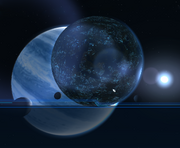Polyphemus (Na'vi name: Naranawm meaning "great eye")[1] is the second of three gas giants and the fourth planet[2] orbiting the star Alpha Centauri A (ACA) in the Alpha Centauri System. Slightly smaller and denser than Jupiter, Polyphemus has no rings and has fourteen moons, the most notable being Pandora. Humanity discovered the gas giant somewhere between 2030 and 2057[3], using a ground-based telescope named COSTIN. Originally, the planet was named "Coeus" after a titan of Greek mythology, however the name was later changed to its current one.
Description[]
Visually, Polyphemus resembles a slightly smaller, blue and purple version of Jupiter, with less prominent bands and a larger vortex storm. This large, eye-shaped storm is the source of the planet's name, being that Polyphemus is the gigantic, cyclops son of Poseidon and Thoosa in Greek mythology, appearing in Homer's epic "The Odyssey". Unlike other gas giants, Polyphemus has no visible rings.

Polyphemus compared with Jupiter
In addition to the fourteen moons orbiting Polyphemus, there is a large and a small planetoid at the gas giant's L4 and L5 Lagrangian points respectively. Since Polyphemus' orbit lies in ACA's habitable zone, appropriately sized planets or moons may have liquid surface water, and therefore support life.
Polyphemus can be seen in the sky on Pandora. Depending on where the moons are in their orbits, Pandora may also have two or even three moons in its sky at once. Depending on ACA's position, Pandora and the other large moons cast dark shadows on Polyphemus, like beauty marks.

Polyphemus with moons
As with all gas giants (especially gas giants close to the parent star, as with Polyphemus), this planet is surrounded by a lethal halo of charged particles (the radiation belts around Polyphemus are more energetic than the belts surrounding Jupiter); the innermost moonlets of Polyphemus have reported radiation in excess of 4500 rem per day (Io receives 3200 rem per day), which is aggravated due to the higher metallicity in the planets' internal composition. Pandora resides just outside the main radiation belts of Polyphemus, except for a week, when rotating along the night side of Polyphemus. At that time, the planet is shrouded at night in a shimmering aurora, and receives a scourge of radiation. Pandoran life has evolved to not be affected by strong ionizing radiation, but humans on Pandora routinely take iodine supplements and seek protection during radiation storms; even then, incidences of radiation-related sicknesses absorb a significant part of medical treatments for personnel stationed on Pandora.
Internal Structure[]
Beneath the liquid droplet clouds that make up its visible 'surface', Polyphemus's atmosphere gradually thickens as its temperature and pressure build up from gravitational compression. When the pressure reaches about two megabars (approximately 29,000,000 pounds per square inch, which is almost two million times Earth's sea level atmospheric pressure) and the temperature reaches about 6000K (10,340F, slightly hotter than the surface of the Sun), hydrogen undergoes a phase change to its metallic form. The size of the liquid metal portion is about three-quarters of the planet's total diameter. This feature is common to all but the smallest gas giants.
Continuing downward, there is a central core of molten iron, surrounded by a thin jacket of lighter, rockier material. Large amounts of iron are not commonly found in gas giants as they have mainly rocky cores.
Polyphemus has an intense internal heat source that results from the gravitational energy released during the contracting of the gases from which it is formed. Additionally, as hydrogen and helium were compressed, they changed from gases to liquids. This released their 'latent heat' (also called the 'heat of vaporisation', which is the amount of energy it takes to evaporate a liquid into a gas). Finally, some of the helium that dissolved in the metallic hydrogen core condensed out & moved downwards, converting its gravitational potential energy into heat via friction processes.[4]
Real Life[]
There is an actual exoplanet candidate discovered in 2021 where Polyphemus would be around Alpha Centauri A, named Candidate 1 or Alpha Centauri Ab.[5] This planet could be up to half the mass of Saturn, which makes it smaller than Polyphemus is said to be (roughly Saturn-sized). Nevertheless, it is in the habitable zone and could host habitable moons or trojan planets.
Gallery[]
Source[]
References[]
- ↑ http://naviteri.org/2016/06/mrrvola-lifyavi-amip-forty-new-expressions/
- ↑ MikkoWilson.Com - Avatar: The Exhibition photogallery
- ↑ Pandora was discovered in 'the late 21st century' ie 2050 at the earliest, and Polyphemus two decades beforehand (in 2030 at the earliest), according to Avatar: The Game's Pandorapedia. The first landings on Pandora were in 2084, so allowing time for travel it was discovered in 2077 at the latest, providing us with a latest-possible discovery for Polyphemus in 2057.
- ↑ Avatar: The Game - Ingame Pandorapedia
- ↑ [1]The planet is still unconfirmed, and further studies are needed to confirm or refute its existence. However, if it does exist, it is surprisingly similar to Polyphemus in terms of its attributes.